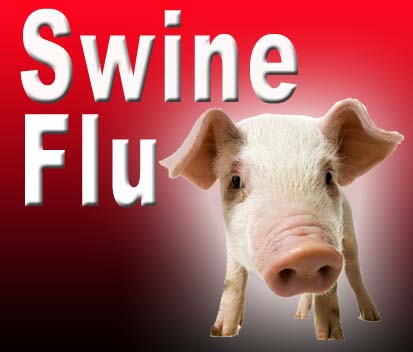sebagai panduan kita bersama...
Apa itu Influenza A H1N1?
Viral Novel Influenza type A H1N1. Ianya berasal dari Virus Avian Flu (Selsema Burung H5N1) yang telah menjangkiti Babi @ Khinzir dan telah bergabung dengan Swine Flu (yang sepatutnya hanya menjangkiti ternakan Babi sahaja) dan telah evaluasi (Mutasi) untuk penyesuaian diri di dalam 'host' yang lebih tinggi didalam rantaian makanan@manusia Dan semasa didalam badan manusia, sekali lagi ia berevolusi supaya ia menjadi 'air born' dan menjangkit dari manusia kepada manusia.
Jangka Hayat Virus
Oleh kerana ia adalah Virus yang 'air born', ia hanya boleh bertahan di udara selama 2 hingga 8 jam sahaja. Jika selepas tempoh tersebut ia tidak mendapat perumah @ host ( badan manusia) ia akan mati. Maka bilik yang dibiarkan selama 24 jam dengan air ventilation yg baik, akan 'bersih' dr virus tersebut.
Apa Yang Perlu Tahu
Asal virus ini:
Sebenarnya telah terdapat outbrake di US sebelum terjadi outbrake di Mexico tapi tidak dilaporkan kepada WHO. Kemungkinan outbrake ini telah dikesan dan US mahu 'baling batu sembunyi tangan' lalu tercetus la outbrakedi Mexico .
Virologi Virus H1N1
Incubation Period yang singkat pada purata 2 hari dengan julat 1 - 4 hari
ini bermakna ia cepat menyerang badan manusia setelah ia menjangkiti pesakit pesakit akan menunjukkan simptom selepas 1 hari dijangkiti paling cepat dan selewat-lewatnya hari ke-4 H1N1 sebenarnya adalah Selsema Biasa namun kepada pesakit yang berisiko, ia dapat membunuh. Jika pesakit adalah seorang yg normal, ia hanya akan memberi kesan seperti demam selsema biasa dan batuk.
Cara Serangan
Virus ini boleh disebarkan melalui batuk, bersin dan percakapan.Virus ini akan menyerang sistem pernafasan (seperti selsema burung dan SARS) peringkat awal, ia hanya pada 'trakea' jika tidak mendapat rawatan awal, ia akan menyerang paru-paru dan boleh menyebabkan kematian akibat 'lung collapse' ia amat merbahaya kepada golongan yangg berisiko tinggi.
Siapa yang berisiko:
1. Orang yang ada masalah 'obesiti' @ gemuk.
2. Perempuan yang mengandung.
3. Orang yang ada asthmatic (Bronkiol Asthma)
4. Orang-orang yang bermasalah dengan sistem imunisasi (menjalani 'operation yg besar', kanak-kanak yang belum cukup suntikan imunisasi, golongan-golongan yang rendah tahap imuniti eg. HIV ext.)
*kematian yang telah dilaporkan terdiri daripada golongan-golongan di atas. 44 kematian di laporkan setakat 12 Ogos 2009.
Simptom-Simptom
hari 1 - rasa kurang sihat, tak bermaya.
hari 2 - selsema, batuk dan demam yg kekal (demam tidak turun walaupun telah makan ubat demam).
hari 3 - rasa kurang selesa di bahagian dada dan sesak nafas.
hari 4 - sakit dada yg teruk jumpa doktor dengan segera.
hari 5 - and above lung collapse @ koma.
Langkah-langkah kawalan
1. Golongan-golongan yang berisiko, elakkan daripada kesesakan (kawasan yang padat dengan orang ramai)
2. Menjaga kebersihan diri, basuh tangan selalu dan dengan betul, jaga kebersihan rumah dan persekitaran .
3. Elakkan diri jika terdapat 'orang batuk, bersin dan kurang sihat' .
4. Jika kurang sihat, elakan diri dari beraktiviti (sosial dan berkumpulan)
5. Jika kurang sihat dan ada ILI ( influenza light illness @ selsema biasa) jangan hadirkan diri di kawasan orang ramai. jika terpaksa, pakai 'mask' (sekurang2 nya 3 ply mask).
6. Untuk orang yang sihat, elakkan dari kawasan yang padat.
7. Jika ada tanda-tanda simptom diatas, segera ke hospital untuk pemeriksaan dan rawatan
8. Jika sihat, jangan ke hospital atau klinik untuk 'checkup' kerana di kawasan tersebut mengandungi banyak virus.
9. Tak perlu ambil anti-viral @ apa-apa ubat influenza. jika sihat dan mengambilnya, akanmengakibatkan resistan (lali) kepada vaksin @ ubat-ubat untuk merawat jika terkena jangkitan. ini adalah kerana berlakunya resistansi virus terhadap persekitaran badan yang telah mengambil ubat-ubat tersebut terlebih awal.
10. Vaksin hanya akan 'wujud' seawal-awalnya pada oktober 09 dan hanya untuk 'frontliner' sahaja dan untuk awam selewat-lewatnya pada 2010.
11. Untuk makluman, influenza test hanya dijalankan di dua makmal sahaja di malaysia, mengambil masa 6 jam untuk run test kepada satu batch sample. Jika klinik menyatakan mereka boleh jalankan ujian, itu tidak betul tak perlu ambil suntikan seasonal influenza kerana ia tidak berkaitan.
12. Tahap kesedaran dan pengetahuan yg tinggi amat perlu untuk kita sama-sama menghadapi outbrake ini. Sama-samalah kita berdoa kepada ALLAH s.w.t agar bala ini cepat berlalu. Amin…
Sumber Rujukan:
Taklimat Influenza A H1N1 oleh Pengarah Kawalan Penyakit Berjangkit dari Kementerian Kesihatan Malaysia di Pan Pasific KLIA pada 01 Ogos 2009. Untuk maklumat lanjut pertanyaan/kemusykilan/soaljawab layari lamanweb Kementerian Kesihatan Malaysia mengenai Influenza A H1N1 http://h1n1.moh.gov.my
CEGAH AWAL DGN MENGUNAKAN PRODUK CELLFOOD...
cegahi sebelum terlambat....
baik untuk H1N1peringkat awal dan segala penyakit barah...



![[2009-05-18_151634.jpg]](http://2.bp.blogspot.com/_SPVPIjuJKYA/ShELfl2YifI/AAAAAAAAAIg/L8bkSRanYbw/s1600/2009-05-18_151634.jpg)
